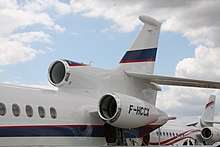Pratt & Whitney Canada PW300
The Pratt & Whitney Canada PW300 series is a family of turbofan jet engines developed by Pratt & Whitney Canada specifically for business jet applications.
| PW300 | |
|---|---|
_cr8.jpg) | |
| PW308 used on the WhiteKnightTwo | |
| Type | Turbofan |
| National origin | Canada |
| Manufacturer | Pratt & Whitney Canada |
| First run | 1988[1] |
| Major applications | Cessna Citation Sovereign Dassault Falcon 2000 Dassault Falcon 7X Fairchild Dornier 328JET Gulfstream G200 |
Design and development
The basic configuration of the PW300 is as follows: single-stage fan, driven by a three-stage low pressure turbine, supercharging a four-stage axial/single-stage centrifugal high-pressure compressor, driven by a two-stage high-pressure turbine. An annular combustor is featured. Some versions have an unmixed exhaust, but the PW306 and PW308 include a forced mixer. A Full Authority Digital Engine Control (FADEC) system is incorporated.
The PW307A is a new centre-line engine developed specifically for a tri-jet application on the Dassault Falcon 7X. The PW307 was certified by Transport Canada in March 2005.
The PW308A has been chosen to power the Scaled Composites White Knight Two, the launch aircraft for Virgin Galactic's SpaceShipTwo.[2]
Unscheduled interventions went from 85% in 2015 to 20% in 2017, driving up the PW307 availability thanks to Pratt's digital platform, and engine dispatch reliability is at 99.4% for the Falcon 7X/8X powered by the PW307.[3]
Variants

.jpg)
.jpg)
- PW305A
- 20.81kN variant used on the Bombardier Learjet 60
- PW305B
- 23.41kN variant used on the Hawker 1000
- PW306A
- 25.36kN variant used on the IAI Galaxy & Gulfstream G200
- PW306B
- variant used on the Dornier 328JET
- PW306C
- 25.67kN variant used on the Cessna Citation Sovereign
- PW306D
- 26.28kN variant used on the Cessna Citation Sovereign +
- PW306D1
- 25.6 kN variant used on the Cessna Citation Latitude
- PW307A
- 28.49kN variant used on the Dassault Falcon 7X[4] Originally 6,100lb-thrust (27.1kN) growth version of the PW306, smaller than the PW308, featuring swept-blade fan, increased core airflow, low NOx emissions combustor, increased turbine capacity and a more efficient exhaust mixer; integrated propulsion system including Macchi/Hurel Dubois nacelle and thrust-reverser; certification scheduled for the end of 2004.[5]
- PW307B
- variant used on the Bombardier Learjet 85
- PW307D
- variant used on the Dassault Falcon 8X
- PW308A
- 30.69kN (6900 lb) variant used on the Hawker 4000 & Scaled Composites White Knight Two[6]
- PW308C
- 31.14kN variant used on the Dassault Falcon 2000EX/DX/LX
Applications
Specifications (PW306B)
Data from Jane's all the World's Aircraft 1993–94[7]
General characteristics
- Type: Turbofan
- Length: 2,062 mm (81.2 in)
- Diameter: 970.3 mm (38.20 in)
- Dry weight: 450 kg (990 lb) installed
Components
- Compressor: 1-stage fan, 4-stage axial with 1-stage centrifugal HPC
- Combustors: Annular
- Turbine: 2 stage high pressure, 3 stage low pressure turbines.
- Fuel type: Aviation Kerosene such as JP-1, JP-4, JP-5 or CPW-204
- Oil system: Pressure spray integral system with gear pump and scavenge, capacity 2.11 US gal (1.76 imp gal; 8.0 l)
Performance
- Maximum thrust: 23.24 kN (5,220 lbf) for take-off or flat-rated at 21.13 kN (4,750 lbf) up to 25 °C (77 °F)
- Cruise thrust: 5.03 kN (1,130 lbf) at M0.8 at 12,200 m (40,000 ft)
- Overall pressure ratio: Core pressure ratio : 15:1
- Bypass ratio: 4.5
- Specific fuel consumption: 41.5 kg/kN/h (0.407 lb/lbf/h) at take-off
- Cruise s.f.c.: 69.9 kg/kN/h (0.685 lb/lbf/h)
- Thrust-to-weight ratio: 5.26 at take-off power
See also
Comparable engines
- Honeywell ALF 502/Honeywell LF 507
- Honeywell HTF7000
- Rolls-Royce AE 3007
Related lists
References
- "V.2500 flies in May". Flight International. 8 April 1988.
- Press release preview Archived 2008-05-17 at the Wayback Machine
- Matt Thurber (October 9, 2017). "PurePower PW800 Nearing Entry Into Service". AIN.
- "Type certificate data sheet No. A59NM" (PDF). FAA. June 27, 2016. Archived from the original (PDF) on December 5, 2017. Retrieved April 28, 2017.
- Graham Warwick (13 Nov 2001). "Latest P&WC turbofan set to power Dassault Falcon 7X corporate jet". Flight International.
- Archived February 21, 2010, at the Wayback Machine
- Taylor, Michael J.H.; Lambert, Mark; Munson, Kenneth, eds. (1993). Jane's all the World's Aircraft 1993–94 (84th ed.). Coulson, Surrey, UK: Jane's Information Group. p. 604. ISBN 978-0710610669.
External links
| Wikimedia Commons has media related to Pratt & Whitney Canada PW300. |